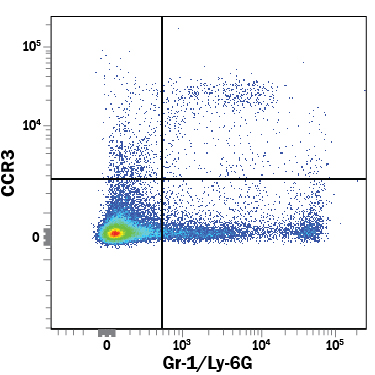Mouse CCR3 PE-conjugated Antibody Summary
Met1-Phe359
Accession # P51678
Applications
Please Note: Optimal dilutions should be determined by each laboratory for each application. General Protocols are available in the Technical Information section on our website.
Scientific Data
 View Larger
View Larger
Detection of CCR3 in Mouse Splenocytes by Flow Cytometry. Mouse splenocytes were stained with Rat Anti-Mouse CCR3 PE-conjugated Monoclonal Antibody (Catalog # FAB729P) and Rat Anti-Mouse Gr-1/Ly-6G Fluoresein-conjugated Monoclonal Antibody (Catalog # FAB1037F). Quadrant markers were set based on control antibody staining (Catalog # IC006P). View our protocol for Staining Membrane-associated Proteins.
Reconstitution Calculator
Preparation and Storage
- 12 months from date of receipt, 2 to 8 °C as supplied.
Background: CCR3
CCR3 is a G protein-linked seven transmembrane receptor that is activated by several different chemokines. It is expressed on subsets of granulocytes, monocytes, T cells and epithelial cells.
Product Datasheets
Citations for Mouse CCR3 PE-conjugated Antibody
R&D Systems personnel manually curate a database that contains references using R&D Systems products. The data collected includes not only links to publications in PubMed, but also provides information about sample types, species, and experimental conditions.
12
Citations: Showing 1 - 10
Filter your results:
Filter by:
-
CCR3-dependent eosinophil recruitment is regulated by sialyltransferase ST3Gal-IV
Authors: Immler, R;Nussbaumer, K;Doerner, A;El Bounkari, O;Huber, S;Abisch, J;Napoli, M;Schmidt, S;Margraf, A;Pruenster, M;Rohwedder, I;Lange-Sperandio, B;Mall, MA;de Jong, R;Ohnmacht, C;Bernhagen, J;Voehringer, D;Marth, JD;Frommhold, D;Sperandio, M;
Proceedings of the National Academy of Sciences of the United States of America
Species: Transgenic Mouse, Mouse
Sample Types: Whole Cells
Applications: Flow Cytometry -
Allergen Delivery Inhibitors: Characterisation of Potent and Selective Inhibitors of Der p 1 and Their Attenuation of Airway Responses to House Dust Mite Allergens
Authors: J Zhang, J Chen, J Zuo, GK Newton, MR Stewart, TR Perrior, DR Garrod, C Robinson
Int J Mol Sci, 2018-10-15;19(10):.
Species: Mouse
Sample Types: Whole Cells
Applications: Flow Cytometry -
A prominent air pollutant, Indeno[1,2,3-cd]pyrene, enhances allergic lung inflammation via aryl hydrocarbon receptor
Authors: TH Wong, CL Lee, HH Su, CL Lee, CC Wu, CC Wang, CC Sheu, RS Lai, SY Leung, CC Lin, YF Wei, CJ Wang, YC Lin, HL Chen, MS Huang, JH Yen, SK Huang, JL Suen
Sci Rep, 2018-03-26;8(1):5198.
Species: Mouse
Sample Types: BALF
Applications: Flow Cytometry -
Self-renewal and phenotypic conversion are the main physiological responses of macrophages to the endogenous estrogen surge
Authors: G Pepe, D Braga, TA Renzi, A Villa, C Bolego, F D'Avila, C Barlassina, A Maggi, M Locati, E Vegeto
Sci Rep, 2017-03-20;7(0):44270.
Species: Mouse
Sample Types: Whole Cells
Applications: Flow Cytometry -
CCL2/CCR2 Regulates the Tumor Microenvironment in HER-2/neu-Driven Mammary Carcinomas in Mice
PLoS ONE, 2016-11-07;11(11):e0165595.
Species: Mouse
Sample Types: Whole Cells
Applications: Flow Cytometry -
Over-expression of the LTC4 synthase gene in mice reproduces human aspirin-induced asthma.
Authors: Hirata H, Arima M, Fukushima Y, Honda K, Sugiyama K, Tokuhisa T, Fukuda T
Clin. Exp. Allergy, 2011-03-24;41(8):1133-42.
Species: Mouse
Sample Types: Whole Cells
Applications: Flow Cytometry -
Impaired basophil induction leads to an age-dependent innate defect in type 2 immunity during helminth infection in mice.
Authors: Nel HJ, Hams E, Saunders SP
J. Immunol., 2011-03-11;186(8):4631-9.
Species: Mouse
Sample Types: Whole Cells
Applications: Flow Cytometry -
The TLR7 ligand 9-benzyl-2-butoxy-8-hydroxy adenine inhibits IL-17 response by eliciting IL-10 and IL-10-inducing cytokines.
Authors: Vultaggio A, Nencini F, Pratesi S, Maggi L, Guarna A, Annunziato F, Romagnani S, Parronchi P, Maggi E
J. Immunol., 2011-03-09;186(8):4707-15.
Species: Mouse
Sample Types: Whole Cells
Applications: Flow Cytometry -
Anti-Siglec-F antibody reduces allergen-induced eosinophilic inflammation and airway remodeling.
Authors: Song DJ, Cho JY, Lee SY, Miller M, Rosenthal P, Soroosh P, Croft M, Zhang M, Varki A, Broide DH
J. Immunol., 2009-09-25;183(8):5333-41.
Species: Mouse
Sample Types: Whole Cells
Applications: Flow Cytometry -
Ablation of type I hypersensitivity in experimental allergic conjunctivitis by eotaxin-1/CCR3 blockade.
Authors: Miyazaki D, Nakamura T, Ohbayashi M, Kuo CH, Komatsu N, Yakura K, Tominaga T, Inoue Y, Higashi H, Murata M, Takeda S, Fukushima A, Liu FT, Rothenberg ME, Ono SJ
Int. Immunol., 2009-01-15;21(2):187-201.
Species: Mouse
Sample Types: Whole Cells
Applications: Flow Cytometry -
Sensitization by intratracheally injected dendritic cells is independent of antigen presentation by host antigen-presenting cells.
Authors: Kuipers H, Soullie T, Hammad H, Willart M, Kool M, Hijdra D, Hoogsteden HC, Lambrecht BN
J. Leukoc. Biol., 2008-10-15;85(1):64-70.
Species: Mouse
Sample Types: BALF
Applications: Flow Cytometry -
Treatment with anti-CC chemokine receptor 3 monoclonal antibody or dexamethasone inhibits the migration and differentiation of bone marrow CD34 progenitor cells in an allergic mouse model.
Authors: Ben S, Li X, Xu F, Xu W, Li W, Wu Z, Huang H, Shi H, Shen H
Allergy, 2008-09-01;63(9):1164-76.
Species: Mouse
Sample Types: Whole Cells
Applications: Flow Cytometry
FAQs
No product specific FAQs exist for this product, however you may
View all Antibody FAQsReviews for Mouse CCR3 PE-conjugated Antibody
Average Rating: 3 (Based on 1 Review)
Have you used Mouse CCR3 PE-conjugated Antibody?
Submit a review and receive an Amazon gift card.
$25/€18/£15/$25CAN/¥75 Yuan/¥2500 Yen for a review with an image
$10/€7/£6/$10 CAD/¥70 Yuan/¥1110 Yen for a review without an image
Filter by:




